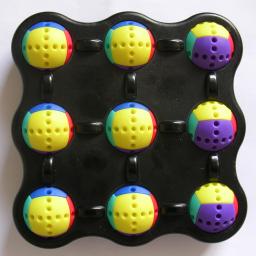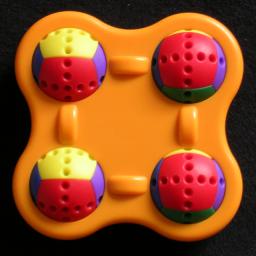



This puzzle consists of a frame containing a 3×3 array of coloured balls. The balls are identical, and have 6 colours, arranged like the 6 sides of a cube. If you rotate any ball to the left or right, all three balls in the same row are rotated in the same way. If you rotate a ball up or down, then the balls in the same column rotate with it. The aim is of course to get all the balls in the same orientation, so that they show the same colour on the front and sides.
The Cmetrick Mini is just the same as the ordinary Cmetrick, except that it is a 2×2 square, so only has 4 balls. It is of course easier to solve, but also easier to handle because it is easier to keep the balls aligned enough to do the moves.
This puzzle is related to the Rolling Cubes Puzzle in that it has a 3×3 array containing cubes which are reoriented. Mechanically it is somewhat related to the Rubik's Clock, as the nine parts are connected with an internal set of cogs. With regards to difficulty this puzzle is more like the Rubik's Clock than the Rolling Cubes Puzzle.
CMetrick was invented and patented by Dror Rom, 8 January 2004, WO 2004/002587.
If your browser supports JavaScript, then you can play the Cmetrick or Cmetrick Mini by clicking the links below:
The parity restrictions can be worked out by using linear algebra the same way
as the Lights Out puzzles, as explained on the
Lights Out Maths page. Suppose we ignore the ball
orientations, and only keep track of the orientation parities. There are then
only six ways that the parities change by a move - changing all the parities in
a column or a row. These six ways are not independent, since the sum of all
six have no effect, but any five of them are. This means that there are exactly
25 ways to affect the parities, instead of the 29 which
you would have if there were no restrictions. This is where the factor 24
comes from in the previous paragraph.
There is another way to look at the same thing. Consider four balls in
a 2×2 square. Any move on the Cmetrick will change the parity of zero or
two of these balls. The number of balls with odd parity in this square will
therefore always remain even. From this it is easy to see that once the balls
on the middle row and column of the Cmetrick are known, the parities of the
corner balls can be determined. Again, this is the factor 24 above.
The Cmetrick Mini has 4 cubes, each with 24 possible orientations, so this gives an upper bound of 244 positions. On this puzzle there is only one parity restriction, so the number of positions is 244/2 = 165,888. Again there are in fact 24 solutions, so if we consider identical any positions that differ only by recolouring then there are really only 243/2 = 6,912 positions.
Stefan Pochmann has calculated the number of positions at each depth of the Cmetrick, and his results are shown below left. It shows that in the worst case only 15 quarter turns are needed to solve the puzzle (12.254 on average). Below right are my results for the Cmetrick Mini, showing you need at most 9 quarter turns to solve it (6.4748 on average) or 8 moves (6.0569 on average) if a half turns counts as one move.
|
| |||||||||||||||||||||||||||||||||||||||||||||||||||||||||||||||||||||||||||||||||||||||||||||||||||||||||||||||||||||||||||||||||||||||||||||||||||||||||||||||||||||||||||||||||||||
Phase 1: Solve the edge balls, forming a cross.
The centre ball will be considered already solved. In this phase, the balls
adjacent to the centre will be solved.
Phase 2: Solve the corner balls.
You can now optionally reorient all the balls by turning all rows or all columns in the same way.